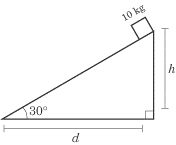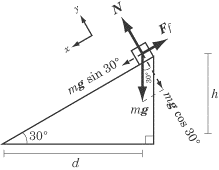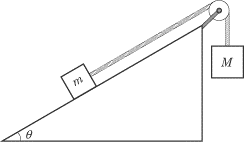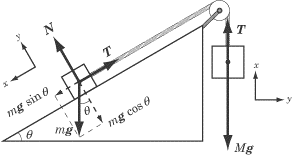英华教育(青岛)语言中心--SAT物理:Inclined Planes-英华外语整理SAT物理:Inclined Planes,供学员学习。班制灵活,随报随学,英华教育咨询热线:400-0532-757
What we call wedges or slides in everyday language are called inclined planes in physics-speak. From our experience on slides during recess in elementary school, sledding down hills in the winter, and skiing, we know that when people are placed on slippery inclines, they slide down the slope. We also know that slides can sometimes be sticky, so that when you are at the top of the incline, you need to give yourself a push to overcome the force of static friction. As you descend a sticky slide, the force of kinetic friction opposes your motion. In this section, we will consider problems involving inclined planes both with and without friction. Since they’re simpler, we’ll begin with frictionless planes. Frictionless Inclined Planes Suppose you place a 10 kg box on a frictionless 30o inclined plane and release your hold, allowing the box to slide to the ground, a horizontal distance of d meters and a vertical distance of h meters.

Before we continue, let’s follow those three important preliminary steps for solving problems in mechanics:Ask yourself how the system will move: Because this is a frictionless plane, there is nothing to stop the box from sliding down to the bottom. Experience suggests that the steeper the incline, the faster an object will slide, so we can expect the acceleration and velocity of the box to be affected by the angle of the plane. Choose a coordinate system: Because we’re interested in how the box slides along the inclined plane, we would do better to orient our coordinate system to the slope of the plane. The x-axis runs parallel to the plane, where downhill is the positive x direction, and the y-axis runs perpendicular to the plane, where up is the positive y direction. Draw free-body diagrams: The two forces acting on the box are the force of gravity, acting straight downward, and the normal force, acting perpendicular to the inclined plane, along the y-axis. Because we’ve oriented our coordinate system to the slope of the plane, we’ll have to resolve the vector for the gravitational force, mg, into its x- and y-components. If you recall what we learned about vector decomposition in Chapter 1, you’ll know you can break mg down into a vector of magnitude cos 30o in the negative y direction and a vector of magnitude sin 30o in the positive x direction. The result is a free-body diagram that looks something like this:

Decomposing the mg vector gives a total of three force vectors at work in this diagram: the y-component of the gravitational force and the normal force, which cancel out; and the x-component of the gravitational force, which pulls the box down the slope. Note that the steeper the slope, the greater the force pulling the box down the slope. Now let’s solve some problems. For the purposes of these problems, take the acceleration due to gravity to be g = 10 m/s2. Like SAT II Physics, we will give you the values of the relevant trigonometric functions: cos 30 = sin 60 = 0.866, cos 60 = sin 30 = 0.500.1. What is the magnitude of the normal force?
2. What is the acceleration of the box?
3. What is the velocity of the box when it reaches the bottom of the slope?
4. What is the work done on the box by the force of gravity in bringing it to the bottom of the plane?
1. What is the magnitude of the normal force? The box is not moving in the y direction, so the normal force must be equal to the y-component of the gravitational force. Calculating the normal force is then just a matter of plugging a few numbers in for variables in order to find the y-component of the gravitational force:

2. What is the acceleration of the box? We know that the force pulling the box in the positive x direction has a magnitude of mg sin 30. Using Newton’s Second Law, F = ma, we just need to solve for a:

3. What is the velocity of the box when it reaches the bottom of the slope? Because we’re dealing with a frictionless plane, the system is closed and we can invoke the law of conservation of mechanical energy. At the top of the inclined plane, the box will not be moving and so it will have an initial kinetic energy of zero . Because it is a height h above the bottom of the plane, it will have a gravitational potential energy of U = mgh. Adding kinetic and potential energy, we find that the mechanical energy of the system is:
At the bottom of the slope, all the box’s potential energy will have been converted into kinetic energy. In other words, the kinetic energy, 1 2 mv2, of the box at the bottom of the slope is equal to the potential energy, mgh, of the box at the top of the slope. Solving for v, we get:

4. What is the work done on the box by the force of gravity in bringing it to the bottom of the inclined plane? The fastest way to solve this problem is to appeal to the work-energy theorem, which tells us that the work done on an object is equal to its change in kinetic energy. At the top of the slope the box has no kinetic energy, and at the bottom of the slope its kinetic energy is equal to its potential energy at the top of the slope, mgh. So the work done on the box is:

Note that the work done is independent of how steep the inclined plane is, and is only dependent on the object’s change in height when it slides down the plane. Frictionless Inclined Planes with Pulleys Let’s bring together what we’ve learned about frictionless inclined planes and pulleys on tables into one exciting über-problem:

Assume for this problem that —that is, mass M will pull mass m up the slope. Now let’s ask those three all-important preliminary questions:Ask yourself how the system will move: Because the two masses are connected by a rope, we know that they will have the same velocity and acceleration. We also know that the tension in the rope is constant throughout its length. Because , we know that when the system is released from rest, mass M will move downward and mass m will slide up the inclined plane. Choose a coordinate system: Do the same thing here that we did with the previous pulley-on-a-table problem. Make the x-axis parallel to the rope, with the positive x direction being up for mass M and downhill for mass m, and the negative x direction being down for mass M and uphill for mass m. Make the y-axis perpendicular to the rope, with the positive y-axis being away from the inclined plane, and the negative y-axis being toward the inclined plane. Draw free-body diagrams: We’ve seen how to draw free-body diagrams for masses suspended from pulleys, and we’ve seen how to draw free-body diagrams for masses on inclined planes. All we need to do now is synthesize what we already know:

Now let’s tackle a couple of questions:
1. What is the acceleration of the masses?
2. What is the velocity of mass m after mass M has fallen a distance h?
1. What is the acceleration of the masses? First, let’s determine the net force acting on each of the masses. Applying Newton’s Second Law we get:

Adding these two equations together, we find that . Solving for a, we get:

Because , the acceleration is negative, which, as we defined it, is down for mass M and uphill for mass m. 2. What is the velocity of mass m after mass M has fallen a distance h? Once again, the in-clined plane is frictionless, so we are dealing with a closed system and we can apply the law of conservation of mechanical energy. Since the masses are initially at rest, . Since mass M falls a distance h, its potential energy changes by –-Mgh. If mass M falls a distance h, then mass m must slide the same distance up the slope of the inclined plane, or a vertical distance of . Therefore, mass m’s potential energy increases by . Because the sum of potential energy and kinetic energy cannot change, we know that the kinetic energy of the two masses increases precisely to the extent that their potential energy decreases. We have all we need to scribble out some equations and solve for v:

Finally, note that the velocity of mass m is in the uphill direction. As with the complex equations we encountered with pulley systems above, you needn’t trouble yourself with memorizing a formula like this. If you understand the principles at work in this problem and would feel somewhat comfortable deriving this formula, you know more than SAT II Physics will likely ask of you. Inclined Planes With Friction There are two significant differences between frictionless inclined plane problems and inclined plane problems where friction is a factor:There’s an extra force to deal with. The force of friction will oppose the downhill component of the gravitational force. We can no longer rely on the law of conservation of mechanical energy. Because energy is being lost through the friction between the mass and the inclined plane, we are no longer dealing with a closed system. Mechanical energy is not conserved. Consider the 10 kg box we encountered in our example of a frictionless inclined plane. This time, though, the inclined plane has a coefficient of kinetic friction of . How will this additional factor affect us? Let’s follow three familiar steps:Ask yourself how the system will move:If the force of gravity is strong enough to overcome the force of friction, the box will accelerate down the plane. However, because there is a force acting against the box’s descent, we should expect it to slide with a lesser velocity than it did in the example of the frictionless plane. Choose a coordinate system: There’s no reason not to hold onto the co-ordinate system we used before: the positive x direction is down the slope, and the positive y direction is upward, perpendicular to the slope. Draw free-body diagrams: The free-body diagram will be identical to the one we drew in the example of the frictionless plane, except we will have a vector for the force of friction in the negative x direction.

Now let’s ask some questions about the motion of the box.
1. What is the force of kinetic friction acting on the box?
2. What is the acceleration of the box?
3. What is the work done on the box by the force of kinetic friction?
What is the force of kinetic friction acting on the box? The normal force acting on the box is 86.6 N, exactly the same as for the frictionless inclined plane. The force of kinetic friction is defined as , so plugging in the appropriate values for and N: Remember, though, that the force of friction is exerted in the negative x direction, so the correct answer is –43.3 N. What is the acceleration of the box? The net force acting on the box is the difference between the downhill gravitational force and the force of friction: . Using Newton’s Second Law, we can determine the net force acting on the box, and then solve for a: Because , the direction of the acceleration is in the downhill direction. What is the work done on the box by the force of kinetic friction? Since W = F · d, the work done by the force of friction is the product of the force of friction and the displacement of the box in the direction that the force is exerted. Because the force of friction is exerted in the negative x direction, we need to find the displacement of the box in the x direction. We know that it has traveled a horizontal distance of d and a vertical distance of h. The Pythagorean Theorem then tells us that the displacement of the box is . Recalling that the force of friction is –43.3 N, we know that the work done by the force of friction is






















 (高老师)
(高老师)


